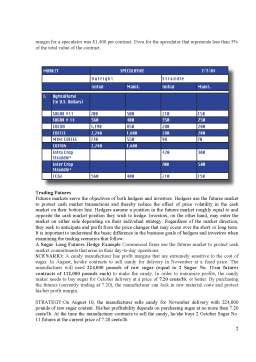Extras din curs
1.1 Americas markets
In the United States, exchange-traded foreign exchange options were introduced in 1982.
Options on foreign currencies presently are traded on the Philadelphia Stock Exchange
(PHLX) and the Chicago Mercantile Exchange (CME). Options on a U.S. dollar index and on the ECU are traded on Finex, the financial division of the New York Cotton Exchange.
The New York Clearing Corporation (NYCC) – the clearinghouse for all trades in the NYBOT markets – guarantees contract performance to its members by establishing, with the exchange, minimum margin levels for each market and periodically adjusting them to reflect current price volatility. The clearinghouse is made up primarily of brokerage firms who serve as clearing members and must meet certain financial requirements and responsibilities including a guaranty deposit at the clearinghouse.
The NYCC serves as counterparty to every trade and guarantees the integrity of each contract in the NYBOT markets. The clearinghouse also oversees the transfer of money among mem¬bers. At the close of each trading day, each trader’s account equity is adjusted (marked to the mar¬ket) to reflect price movements. If the market has moved against the trader’s position, variation margin payments may be required to restore the trader’s equity to the required minimum level.
In the traditional exchange, the actual transaction takes place in designated trading rings (pits) where members meet to make bids and offers to each other by voice and hand signals (open outcry). Trades are acknowledged by the participants and confirmed in writing or through an electronic order routing system (EOR). Since only exchange members can trade on the floor, customer orders are delivered to floor brokers who execute them according to the customer’s instructions. Among the common orders that are filled in the pit are market orders (executed immediately at the prevailing price in the pit); limit orders (to be executed at the stated price or better); and stop orders (instructs broker to execute an order at the market if a certain price is reached).
Once the transaction has taken place, it is entered manually or electronically into NYBOT’s Trade Input Processing System (TIPS®) where it is matched, and assigned to a clearing member. Only clearing mem¬bers can submit trades for clearing. When the trade is matched and submitted, the clearinghouse then becomes the buyer to every seller and seller to every buyer.
From the moment the order enters the market, its path is marked clearly in terms of time stamps that record its progress. This path is called an audit trail that helps to protect the interests of all parties involved in the trade. The audit trail is one of the key tools of regulation that govern the futures market and protect the integrity of each trade.
The Transaction
Futures trades begin with one basic step: buyers and sellers deposit funds – called margin – as a per¬formance bond or good faith deposit with a brokerage firm to ensure that market participants will meet their contractual obligations. The margin commitment is the same for both buyers and sellers.
There is often a difference, however, between the margins required of hedgers and the commitments for specula¬tors. This system of initial (or original) margin deposits (usually a small percentage of the total value of the underlying contract) helps to maintain the financial integrity of the futures market and provides participants with the leverage that is a major feature of futures trading. Since a futures contract is not intended for use as a merchandising contract for transfer of title from seller to buyer, there is no need for the full contract value to change hands.
An illustration: On September 10, 2003, the initial margin for a hedger in the Cotton No. 2sm Contract was $1,000 on a contract valued on that day at $30,350 (price = 60.70 cents/lb.). The initial margin for a speculator was $1,400 per contract. Even for the speculator that represents less than 5% of the total value of the contract.I.Agricultural (In U.S. Dollars#.
Trading Futures
Futures markets serve the objectives of both hedgers and investors. Hedgers use the futures market to protect cash market transactions and thereby reduce the effect of price volatility in the cash market on their bottom line. Hedgers assume a position in the futures market roughly equal to and opposite the cash market position they wish to hedge. Investors, on the other hand, may enter the market on either side depending on their individual strategy. Regardless of the market direction, they seek to anticipate and profit from the price changes that may occur over the short or long term. It is important to understand the basic difference in the business goals of hedgers and investors when examining the trading scenarios that follow.
A Sugar Long Futures Hedge Example Commercial firms use the futures market to protect cash market commitments that arise in their day-to-day operations.
SCENARIO: A candy manufacturer has profit margins that are extremely sensitive to the cost of sugar. In August, he/she contracts to sell candy for delivery in November at a fixed price. The manufacturer will need 224,000 pounds of raw sugar (equal to 2 Sugar No. 11sm futures contracts of 112,000 pounds each) to make the candy. In order to maximize profits, the candy maker needs to buy sugar for October delivery at a price of 7.20 cents/lb. or better. By purchasing the futures (currently trading at 7.20), the manufacturer can lock in raw material costs and protect his/her profit margin.
Preview document
Conținut arhivă zip
- Derivatives Instruments.doc






























